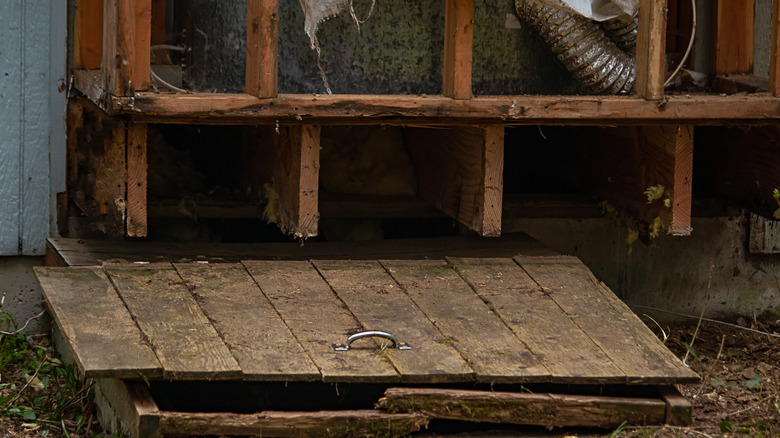A Trip To The Bathroom Put An End To John Wayne Gacy's Crime Spree
Beneath the floorboards of the house on Summerdale Avenue lay the bodies of 27 young men and boys, resting in shallow trenches that were covered by thin layers of earth and quicklime. When investigators began to dig under the Norwood Park, Illinois bungalow of John Wayne Gacy, they were fearful of what they might find (via the Chicago Tribune). A trail of clues led them to this suburban Chicago abode after a teenage boy named Robert Piest had been reported missing days earlier. Piest was working part-time at a local pharmacy and had told a co-worker there that he was going to meet a contractor named Gacy later in the day about extra work. Police discovered that Gacy's name was mentioned as a potential suspect in several other missing person cases (via Esquire), and his rap sheet showed some prison time in Iowa for sexually assaulting a teenage boy a decade earlier (per History).
The hope of finding Piest alive faded as police pieced together what they knew about their prime suspect. Gacy was questioned by police, but officers couldn't find any concrete evidence to arrest him. Yet. Gacy was put under surveillance and tailed everywhere he went. He was fully aware that police were following him and seemed to enjoy toying with them. Esquire reports that on one occasion, Gacy invited two of the officers into his home to dine with him. It was during this encounter that one officer recalls a visit to Gacy's bathroom, which provided a valuable clue later used to get Gacy arrested for murder.
If you or anyone you know has been a victim of sexual assault, help is available. Visit the Rape, Abuse & Incest National Network website or contact RAINN's National Helpline at 1-800-656-HOPE (4673).
Maybe he should have buried them deeper
The smell of decomposing flesh is one that is like no other. For those who have ever had a rodent die inside their walls or had a stray animal crawl under the house and die, they know just how putrid this lingering odor can be. When the two officers accepted John Wayne Gacy's invitation to eat with him, they were thinking that their host was most likely responsible for the disappearance of Robert Piest. After some conversation, one of the officers asked to use Gacy's restroom. Esquire tells of fate intervening while the cop was using these facilities. The furnace kicked on, blowing warmed air from the ductwork into the bathroom. The officer began to notice a horrid stench coming from the vent, one that he later compared to the smell of bodies in the morgue. The Chicago Tribune reports that Gacy's excuse for the smell was a problem with sewage that had been seeping underneath the house.
But that was no sewer smell. The odor was from the 27 bodies that Gacy had buried in shallow graves beneath his floorboards. After police arrested Gacy days later and executed a search warrant on the property, they would spend weeks unearthing the horror that the Killer Clown tried to conceal. It was discovered that Gacy killed at least 33 victims. After he ran out of room in the crawlspace, he used his yard and the Des Plaines River as a dumping ground (via the Chicago Sun-Times).
Gacy would probably have been caught anyway
Would John Wayne Gacy have been caught without that ill-fated trip to the bathroom? All signs point to yes. When Gacy was first questioned by police on December 13, two days after Robert Piest had disappeared, they had enough for a search warrant (via Biography). The Chicago Tribune tells how Gacy gave police his keys willingly, and they began their search. Police confiscated some suspicious items from his house. Among them were numerous driver's licenses belonging to different men and a collection of college rings. They also found a receipt from the pharmacy Piest worked at — it had been placed in his jacket by a co-worker — in Gacy's wastebasket, but no bodies (via the Chicago Tribune).
Crime + Investigation U.K. reports that it was one of those rings that led police right back to Gacy's house with a warrant. The ring belonged to a missing boy named John Szyc. Police were able to at last tie Gacy to a potential homicide with a valuable piece of evidence. In the meantime, Gacy lawyered up and surprisingly gave a confession to his attorney. Days later, Gacy was seen giving a gas station clerk a bag of marijuana, and he was arrested.
By then, police had more than enough evidence to return to Gacy's house with another search warrant. Retrieved items belonging to missing men and boys, the tell-tale pharmacy receipt, and the smell of decaying bodies factored into investigators being allowed into the innocuous-looking bungalow on Summerdale Avenue to conduct a thorough search for bodies. And their noses gave them a great idea of where to start.


